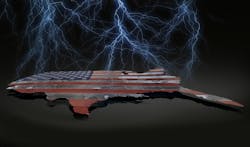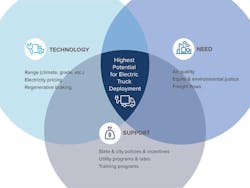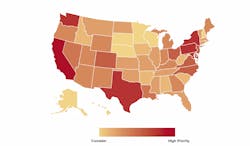After weighing several criteria deemed vital to fostering electrified freight movement, the North American Council on Freight Efficiency (NACFE)—in conjunction with the Rocky Mountain High Institute (RMI)—has identified the regions and specific states ideal for immediate deployments. The details were revealed in the 35-page guidance report called “High Potential Regions for Electric Truck Deployments.”
“This report answered the primary question of what regions are ready now, and it sets up a framework for either national fleets to think about where else they would go,” said Mike Roeth, NACFE’s executive director.
He later added: “This isn't so much about who's taking action to do things. It's more about just the facts, just the reality.”
He gave the example of UPS, which has solid footing in California, but must ponder where the next electric oasis should emerge.
The three judging categories broke down into technology, need and support, all while looking through the lens for sustaining regional hauls, or those less than 300 miles. Previous NACFE studies have concluded regional hauls are best for electrification right now, with long haul being a long-term goal.
The report also assumed these trucks would charge at fixed locations rather than, say, gas stations with added electric infrastructure.
“We see depot charging being the near-term and even medium-term approach for these trucks rather than electric truck charging along corridors,” Roeth said. “We see that coming at some point, but now is the time to work on depot charging.”
"Technology" includes vehicle range, electric pricing and the effectiveness of regenerative braking. "Need" covers air quality, equity and environmental justice, and freight flows. Finally, "support" houses the incentives, expressed interest and funding availability.
The mega-regions with the most potential include: Northern and Southern California, the Texas Triangle, Cascadia, the Rocky Mountain Front Range, and Northeast. Following behind are the Arizona Sun Corridor, Florida, Great Lakes, Gulf Coast and Piedmont Atlantic regions.
As far as specific states ripe for electrification, California, Maryland, New York, Pennsylvania, Texas and Washington earned a rating of “highest priority.” Colorado, Delaware, North Carolina, New Jersey, Ohio and Virginia came in slightly less scorching on the heat map.
One impact this report can have is serving as a wake-up call to regions that may be underestimating their potential.
“We are already seeing strong policy signals in jurisdictions across the U.S., which will help ignite the market for clean trucks by accelerating demand,” said Jason Mathers, director, Vehicles & Freight Strategy, Environmental Defense Fund, in the report. “Now we need supportive policies from state leaders in places like Texas, where conditions are ripe for electric truck deployments, but could use an extra push.”
Along with providing recommendations for the industry, the free-to-download report includes a technical appendix that details the framework of how NACFE and RMI came to their conclusion of whether a state or region should merely consider electric truck deployments or if it should be made a priority.
While these areas are not the only places where fleets, utilities and governmental bodies can work together to create the appropriate infrastructure for electrified regional haul, they are the most promising. Some of this is uncontrollable, such as topography. For instance, a truck driving down a steep hill near Aspen on Interstate 70 will leverage regenerative braking far better—and funnel more energy back to the battery—than one heading into Topeka, Kansas, and thus, will see a bump in range. Climate plays a big role as well. Extreme heat and cold may negatively affect batteries, so a more moderate region will score higher on that metric.
Because fuel is the biggest recurring cost to a trucker or fleet, that was also factored into the rankings.
“Obviously one of the biggest differences between a traditional diesel truck and an electric truck is the ‘fuel source,’ and so we wanted to look at not just where electricity is cheapest, but where is there the most potential for savings compared with diesel?” explained Jessie Lund, the RMI senior associate who co-authored the report with Roeth.
Lund, who did a majority of the data analysis, also said she looked at which regions had the best opportunity for renewable electricity generation, what places would benefit most by improvements in air quality, and where freight is being moved the most.
On the policy end, the recent 15-state Zero Emission Vehicle memorandum of understanding is the type of action that would strengthen a region’s position and could help validate a fleet’s decision to invest in electrification there, though such a decision requires a good amount of due diligence on the fleet’s part.
NACFE included a spreadsheet tool in the download that functions like a cost calculators to help fleets conduct their own analysis.Recommendations on how t move forward were also listed, such as conducting small-scale deployments and sharing data with policymakers.
Roeth noted there is still a lot of work to be done even in areas with optimal conditions, and fleets must work to find where charging should go, how to address the complex permitting required to install the charging infrastructure, and a host of other factors.
"We are at the early stages of freight electrification, and while the future is electric, it requires everyone including the fleet, the utility, the OEM, the charging supplier, the permitting jurisdiction, and potential funding providers to all come together,” offered Ben Prochazka, national director, Electrification Coalition, in the report. “As fleets are getting started, they should make sure to pick the right location to ensure the greatest opportunity for success."
About the Author
John Hitch
Editor
John Hitch is the editor-in-chief of Fleet Maintenance, providing maintenance management and technicians with the the latest information on the tools and strategies to keep their fleets' commercial vehicles moving. He is based out of Cleveland, Ohio, and was previously senior editor for FleetOwner. He previously wrote about manufacturing and advanced technology for IndustryWeek and New Equipment Digest.




